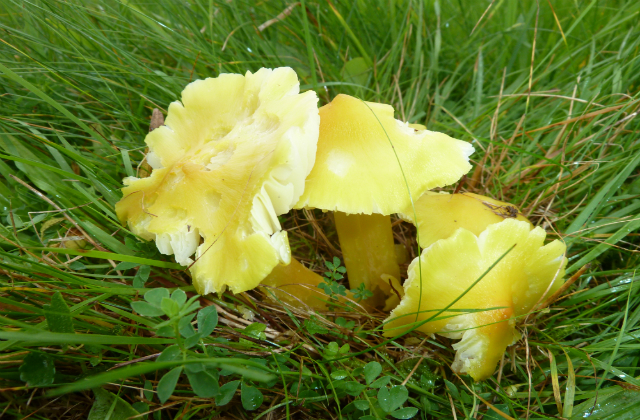Fungi protected at new sites

There has been coverage today in the Express and Star and Dudley News of Natural England’s announcement of the notification of two Sites of Special Scientific Interest (SSSIs) because of rare fungi.
This doubles the number of sites chosen for designations specifically for their fungi. These two new SSSIs provide protection for over 70 additional hectares for important and spectacular fungi, as well as nationally important grasslands and meadows.
The first site is Dorset’s Down Farm, an eight hectares site near Beaminster and home to a nationally important assemblage of grassland fungi, in particular a rich variety of waxcaps and clubs, corals and spindles. These fungi thrive in traditionally managed grasslands and Down Farm’s richness is testament to the careful stewardship by the land owner.
Andrew Smith, Natural England’s area manager for Dorset said:
This Site of Special Scientific Interest designation is a reflection of how rare and special Down Farm is as a place for nature.
This ‘waxcap’ grassland in west Dorset is now recognised as being of national importance. Notifying the meadow helps safeguard these important natural features that the land owner has nurtured and cared for so well through traditional hay meadow management. Natural England is delighted to recognise the owner’s good work and looks forward to this spectacular place being cherished long into the future.
Natural England, and the many people and organisations we work with, are so pleased we can take this important step to ensuring this site has a secure and healthy future. We are grateful to the owner of the meadows and to our partners who have worked with us to establish this designation.
The second notification is The Leasowes in Halesowen, an area of 63 hectares in the borough of Dudley near Birmingham and one of the best sites in England for its spectacular displays of grassland fungi, including an amazing 28 species of the brightly coloured waxcap mushrooms.
The citrine waxcap, which is on the International Union for Conservation of Nature's global red data list - a list of species at threat of extinction - was recorded at The Leasowes in 2017.
Pink, golden and parrot waxcaps are amongst the other species spotted at the site off Mucklow Hill.
Emma Johnson, Natural England’s area manager for West Midlands said:
England’s Sites of Special Scientific Interest are essential to look after the very best examples of our precious natural heritage and wildlife for generations to come. We are delighted to designate the rare species-rich pastures and grassland fungi at The Leasowes.
It is a great example of how urban sites can hold nationally significant habitats, providing a wonderful place for both people and nature. The designation is a timely recognition of all of the management and conservation work that has gone into the site by wardens, golf course managers, volunteers and community groups over many years.
SSSIs protect the very best examples of our precious natural heritage and wildlife for the future. Natural England plays a pivotal role in designating these sites, monitoring and reporting their condition and advising landowners on their management.
These notifications take the total number of English grassland SSSIs selected for fungi up to four. The Joint Nature Conservation Committee has recently published new guidelines for the selection of SSSIs for fungi which were used for the first time in the selection of these sites.
Tim Wilkins, Natural England’s Senior Specialist in fungi, said:
There are very few grasslands in the whole of England that support such a spectacular array of fungi. This reflects the great antiquity of the grassland at The Leasowes, all the more remarkable for its proximity to the Birmingham conurbation.
As well as the colourful waxcap mushrooms, the site is also important for its fairy club fungi and earth-tongues. It’s great to know that this site and its wonderful fungi will be preserved for current and future generations to enjoy.
Dr Martyn Ainsworth, Research Leader in Mycology, Royal Botanic Gardens, Kew and co-author of the new guidelines for the selection of fungal SSSIs, said:
It is just brilliant to see two more English SSSIs notified for their spectacular and enigmatic waxcap grassland fungi, which are in general decline right across Europe.
It is especially encouraging and uplifting to note that these designations have occurred so soon after the publication of the new guidelines for selecting such important fungal sites.
British Lung Foundation’s report

There has been national and trade coverage in the Daily Express, Times, i news, Business Green, AirQualityNews and Energy Live News of the British Lung Foundation’s ‘Toxic air at the doors of the NHS’ report based upon new analysis by UK100 green cities network. Findings from UK100 analysis states that 1 in 3 NHS patients (17.9 million) in England are registered at a GP practice that exceeds the World Health Organization’s (WHO) annual limit for Particulate Matter (PM2.5). UK100 are calling for leadership from the Government to tackle the problem with new laws and funding for local authorities to clean up their air. Coverage states that experts are calling for an independent watchdog to allow charities and non-governmental organisations to hold ministers to account, whilst campaigners are pushing for ministers to adopt WHO air pollution targets.
On 14 January the Government launched our new and ambitious world leading Clean Air Strategy that sets out comprehensive action required across all parts of government to improve air quality. Taking the action we have set out will improve air quality and reduce the incidence of serious illness, improving quality of life for tens of thousands of people. It will reduce the costs of air pollution to society by an estimated £1.7 billion every year by 2020, rising to £5.3 billion every year from 2030.
In our strategy we have also committed to publish a report examining the steps needed to meet the WHO guideline limit for PM 2.5 across the UK. Our action will halve the number of people living in areas above the WHO guideline limit.
In December 2018, we published the draft clauses of our flagship Environment Bill. Within this, we set out how we will create a pioneering new system of green governance, placing our 25 Year Environment Plan on a statutory footing. The draft clauses establish a new, independent environment body called the Office for Environment Protection, with the power to bring legal proceedings against the government and create a statutory framework for environmental principles.
Local government has been the main agent for cleaning up local air since before the first Clean Air Act of 1956 as the impacts of air pollution, and the action required to address it, are highly relevant to local government priorities: health, housing, transport, education, local economics, greenspace and quality of life. The Clean Air Strategy includes a commitment to give new powers to local authorities to take action in areas of high pollution.
A Government spokesperson said:
The evidence is clear - air quality has improved significantly in recent years but air pollution continues to shorten lives which is why we are taking concerted action to tackle it.
We’re the first major economy to adopt particulate matter goals based on World Health Organization recommendations, which is why the WHO praised our Clean Air Strategy as an example for the rest of the world to follow. Our forthcoming Environment Bill will also include primary legislation in air quality.